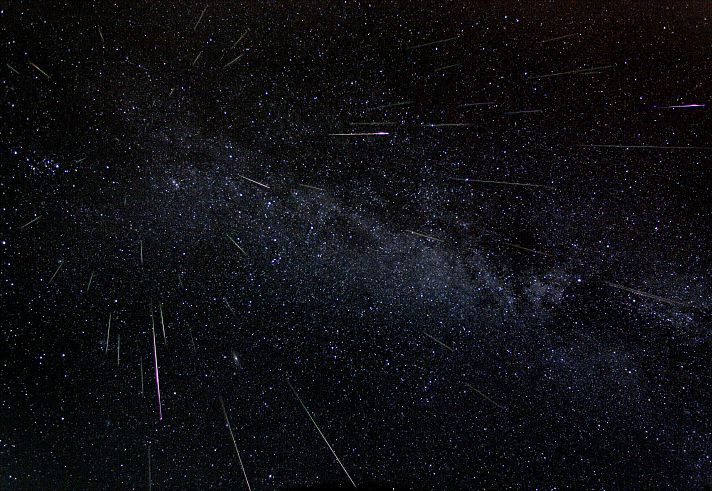Credit & Copyright: Fred Bruenjes
Explanation:
Comet dust rained down on planet Earth last August, streaking
through dark skies in the annual
Perseid meteor shower.
So, while enjoying the
anticipated space weather, astronomer
Fred Bruenjes recorded a series of many 30 second long exposures
spanning about six hours on the night of August 11/12 using a
wide angle lens.
Combining those frames which captured
meteor flashes, he produced
this dramatic view of the
Perseids of summer.
Although the comet dust particles are traveling parallel
to each other, the resulting shower meteors clearly seem to
radiate from a single point on the sky in the
eponymous
constellation Perseus.
The radiant effect is due to
perspective, as the parallel
tracks appear to converge at a distance.
Bruenjes notes that there are 51 Perseid meteors in
the composite image,
including one seen nearly head-on.
This year, the Perseids
Meteor Shower will peak in the
early morning hours on Friday, August 12.
1999 2000 2001 2002 2003 2004 2005 2006 2007 2008 2009 2010 2011 2012 2013 2014 2015 2016 2017 2018 2019 2020 2021 2022 2023 2024 2025 |
Yanvar' Fevral' Mart Aprel' Mai Iyun' Iyul' Avgust Sentyabr' Oktyabr' Noyabr' Dekabr' |
NASA Web Site Statements, Warnings, and Disclaimers
NASA Official: Jay Norris. Specific rights apply.
A service of: LHEA at NASA / GSFC
& Michigan Tech. U.
|
Publikacii s klyuchevymi slovami:
meteor shower - meteor - Meteornyi potok - meteornyi dozhd' - Meteor - radiant - Perseidy
Publikacii so slovami: meteor shower - meteor - Meteornyi potok - meteornyi dozhd' - Meteor - radiant - Perseidy | |
Sm. takzhe:
Vse publikacii na tu zhe temu >> | |
